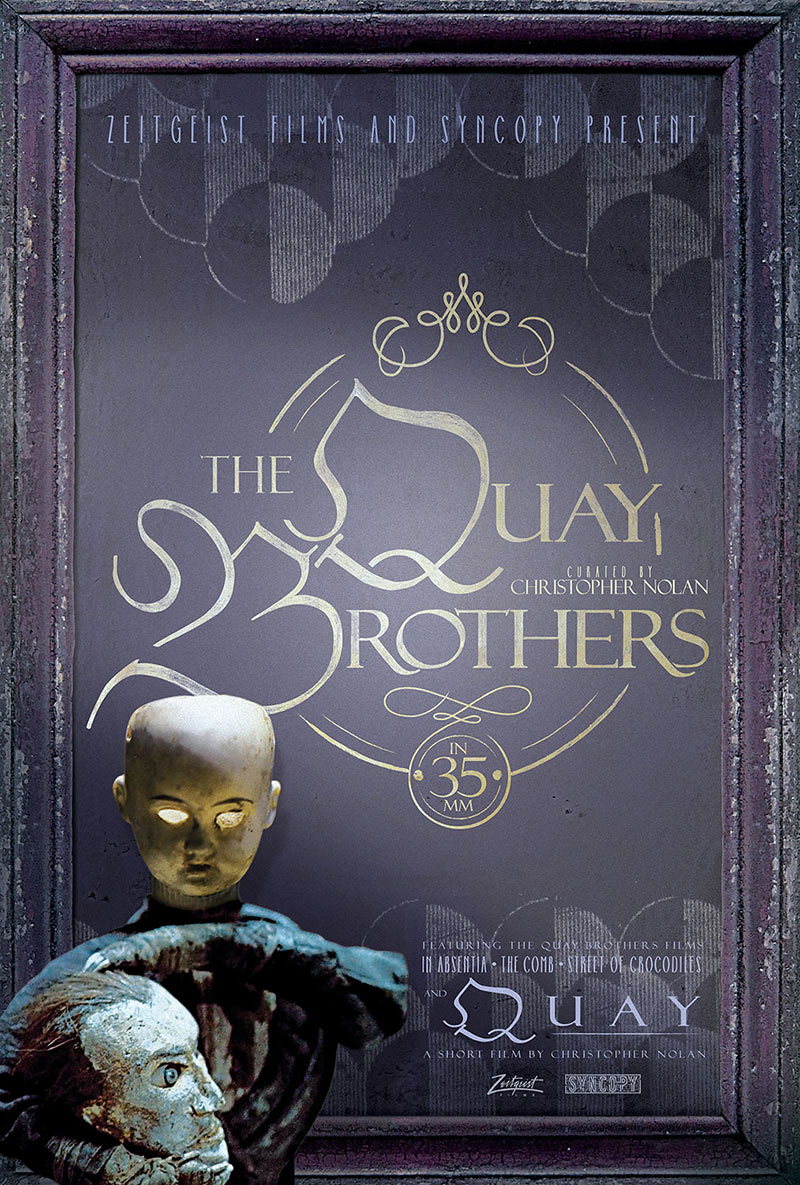

‘We Left the Door Ajar, and Christopher Nolan Slipped In:’ An Interview With The Brothers Quay
Fans of stop-motion surrealism who haven’t been able to witness twin brothers Stephen and Timothy Quay’s fascinating short films currently on tour in 35mm, curated by Inception director Christopher Nolan, can now enjoy the films from the comfort of their own homes.
Nolan’s Syncopy Films and indie film distributor Zeitgeist Films’ comprehensive Blu-ray release, The Quay Brothers: Collected Short Films, features 15 films totaling 225 minutes of strange but rewarding animation, from 1984’s pioneering The Cabinet of Jan Svankmajer to 2003’s The Phantom Museum, which features a restored musical score. It also includes three of the Brothers Quay’s more recent efforts — 2010’s Maska, 2011’s Through the Weeping Glass, and 2013’s Unmistaken Hands — previously uncollected on DVD, as well as Nolan’s respectful new documentary, Quay.
I spoke via email with the prolific American-born, London-based twin auteurs about Nolan’s cinematic analysis of their uncanny work, their exhaustive Blu-ray collection, and the still-underrated state of stop-motion animation.
Cartoon Brew: How did the tour work out?
The Quay Brothers: We were only around for the opening nights at the Film Forum in New York, but Christopher Nolan was a masterful host and presence. We subsequently left to return to London, so we have no idea how the rest of the tour went. But it was no surprise to see how beautiful new 35mm prints can be when projected.
What do you think of Nolan’s documentary?
The Quay Brothers: We left the door ajar, and Christopher Nolan slipped in silently with his camera. He respected us, our space, and our working methods — which we share hugely with him. Ultimately, his film left intact a gentle shroud of mystery.
How would say his films intersect with your own?
The Quay Brothers: He explores the infinitely large and great, whilst we explore the infinitely small and minute. Each shares whole worlds, and shadow worlds, and wormholes.

With the new addition of Maska, Through the Weeping Glass, and Unmistaken Hands to your Blu-ray, is there anything left to add?
The Quay Brothers: Apart from the three new films, and a musical score restored to The Phantom Museum, yes, there are a few others. But these have been left out, as they work better with live performances of the music of Witold Lutosławski, Leoš Janáček, and Bela Bartok, which is how they were commissioned.
Taking in the breadth of your work over time, what kind of statement have you made about independent animation, and staying true to your vision, however dark and singular?
The Quay Brothers: You’d have to admit that at the beginning when we first started out, some of the commissioning bodies like the British Film Institute, Channel 4, or MTV were quite willing to take chances on us, by commissioning projects that clearly were going to explore the marginal realms that appealed to us. But now, having gained a bit more of a reputation, it seems even perversely harder to convince these very same bodies, or newer bodies, to support our newer projects. That perhaps already tells you, and us, a lot that the routes that we’ve taken are decidedly not the routes that these people want to be seen supporting any longer. Our three new films were disparately supported by The Polish Cultural Institute in London, The Mutter Museum in Philadelphia, and the Wexner Center in Ohio.
Even today, I still see arguments that stop-motion is for kids, or isn’t proper animation. What do you think of that? Meanwhile, Shaun the Sheep Movie has been compared to Charlie Chaplin and Buster Keaton, while Charlie Kaufman’s R-rated Anomalisa could be up for an Oscar.
The Quay Brothers: We’re not sure we understand the notion, as we’ve never heard that stop-motion is not considered animation. But we’re very happy to be enlightened. Although we have yet to see Anomalisa, from our own experience puppets and eroticism are very fascinating territory that we too have explored.
Although a good portion of our films may use puppets, we’ve never exclusively courted this domain. We have always incorporated and blended live-action, pixilation, time-lapse, object animation, and traditional stop-motion animation, to the point where, in some of our films, one would be sometimes hard-pressed to know where one realm gave off into the other. And that’s not even mentioning the two feature films we’ve already done.
What have been the struggles, and triumphs, you’ve experienced in pursuing your art and vision through the decades?
The Quay Brothers: The crucial element in our journey has been to know how to stay small, and how to keep the all-important studio going. Because it’s there where our worlds get fabricated, where we have the chance to explore, experiment, and discover. There will always be the huge corporate side of animation, but there will also always be the more artisanal side of animation, with more individual voices. The history of animation has amply proven this.
(Top: The Quay Brothers. Photo © Robin Holland)


